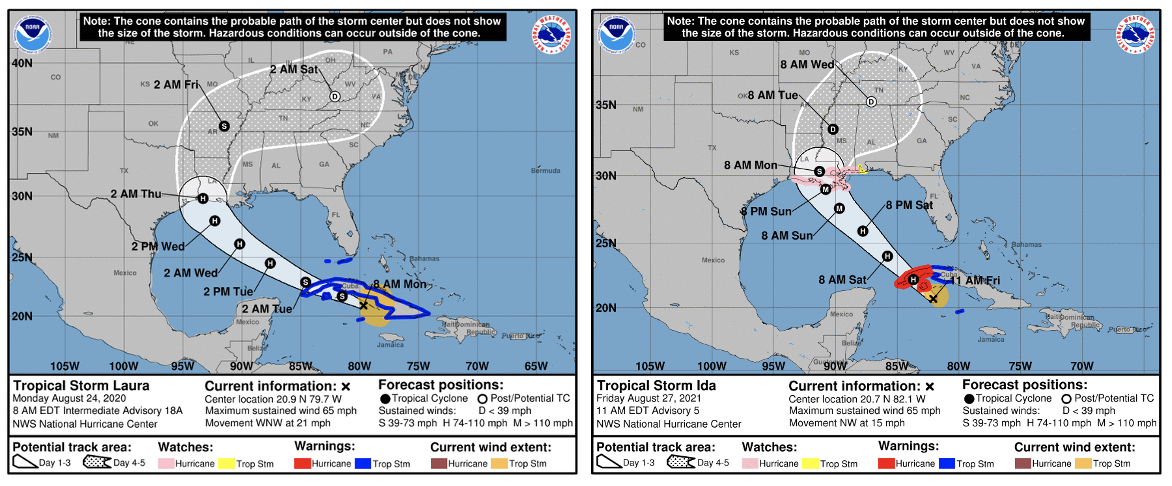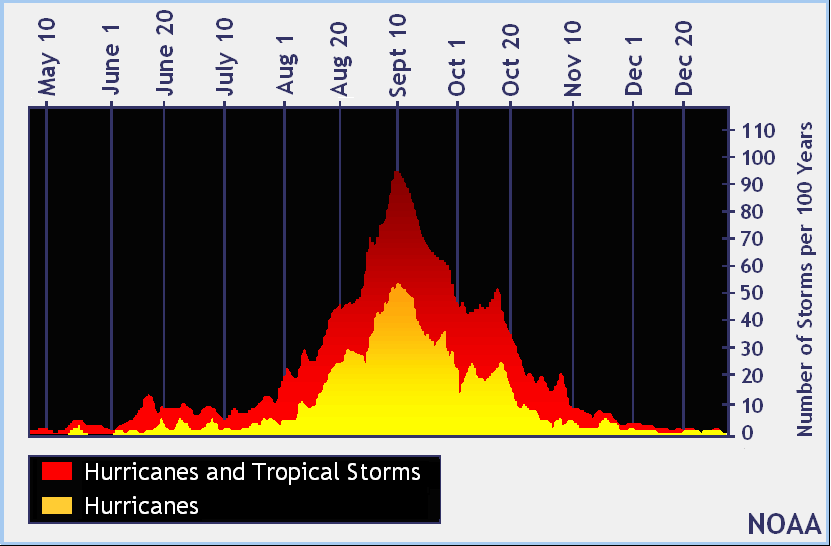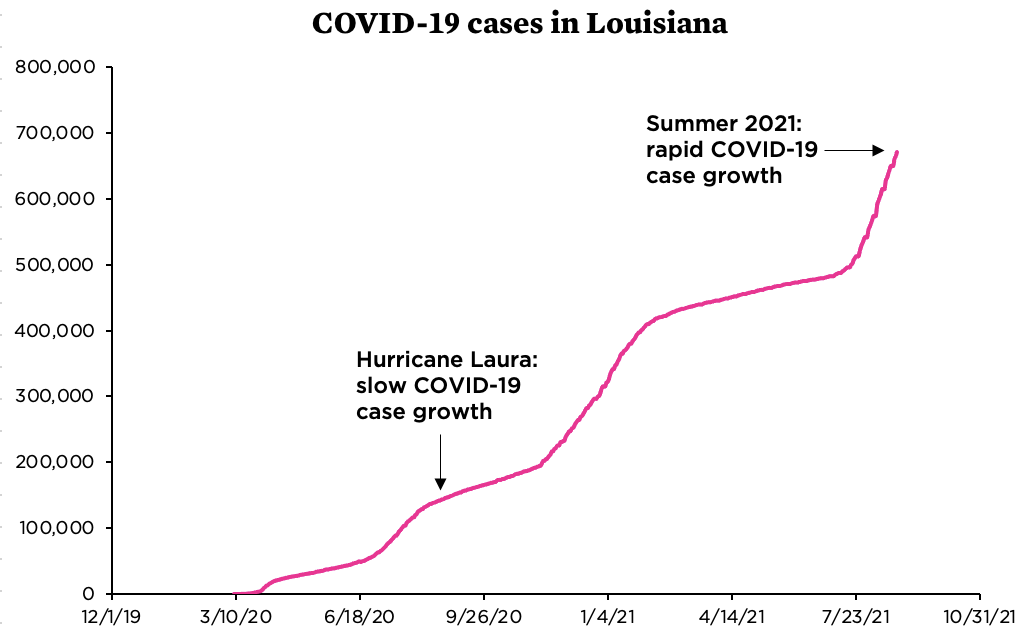August 27, 2021

COAST GUARD NEWS


With COVID-19, it’s worse than Groundhog Day
When Hurricane Laura hit, Louisiana was in between COVID-19 waves, averaging about 600 new cases per day, and no COVID-19 vaccine was available. The latest statistics (as of August 25, 2021) show that Louisiana is now averaging more than 4,500 new cases per day, with 99% of cases caused by the Delta variant as of the week of August 15th. Hospitalizations have also peaked at rates well above the surges that occurred this past winter.


UNION OF CONCERNED SCIENTISTS
A storm system currently named Tropical Storm Ida is expected to strengthen into a hurricane and make landfall in Louisiana early next week after bringing life-threatening rain and flooding to Cuba and other Caribbean islands. For Louisiana communities still rebuilding from three hurricanes–Laura, Delta, and Zeta, which struck the coast last year–the latest forecast threatens to bring additional damage to the region and set recovery efforts back. But with new COVID-19 cases currently at some of their highest rates yet in Louisiana and other Gulf Coast states, and with hospitals already overwhelmed, public officials are worried about the region’s ability to maintain public safety in the face of a hurricane.
Louisiana weathered three hurricane strikes last year, when the pandemic was raging and vaccines were not yet available. This year, despite the availability of vaccines for people ages 12 and up and despite the presence of the highly contagious Delta variant of the virus, COVID-19 vaccination rates in Gulf Coast states remain stubbornly below national averages. So we’re about to find out what it looks like when the peak of hurricane season coincides with the crest of the latest wave of COVID-19.
Yes, this is kind of like Groundhog Day
It was almost exactly one year ago this week that Louisiana was struck by Hurricane Laura, the strongest hurricane on record to strike southwest Louisiana. Evacuees from coastal communities returned to their neighborhoods after the storm to begin rebuilding their homes and lives. As they did, they were met with a heat wave in which the heat index reached roughly 110°F, power outages that lasted for weeks, and, in many cases, a lack of access to drinking water.
A storm system currently named Tropical Storm Ida is expected to strengthen into a hurricane and make landfall in Louisiana early next week after bringing life-threatening rain and flooding to Cuba and other Caribbean islands. For Louisiana communities still rebuilding from three hurricanes–Laura, Delta, and Zeta, which struck the coast last year–the latest forecast threatens to bring additional damage to the region and set recovery efforts back. But with new COVID-19 cases currently at some of their highest rates yet in Louisiana and other Gulf Coast states, and with hospitals already overwhelmed, public officials are worried about the region’s ability to maintain public safety in the face of a hurricane.
Louisiana weathered three hurricane strikes last year, when the pandemic was raging and vaccines were not yet available. This year, despite the availability of vaccines for people ages 12 and up and despite the presence of the highly contagious Delta variant of the virus, COVID-19 vaccination rates in Gulf Coast states remain stubbornly below national averages. So we’re about to find out what it looks like when the peak of hurricane season coincides with the crest of the latest wave of COVID-19.
Yes, this is kind of like Groundhog Day
It was almost exactly one year ago this week that Louisiana was struck by Hurricane Laura, the strongest hurricane on record to strike southwest Louisiana. Evacuees from coastal communities returned to their neighborhoods after the storm to begin rebuilding their homes and lives. As they did, they were met with a heat wave in which the heat index reached roughly 110°F, power outages that lasted for weeks, and, in many cases, a lack of access to drinking water.

In August, 2020, Hurricane Laura (left) made landfall near Lake Charles, Louisiana. Almost exactly one year after Laura and 16 years after Hurricane Katrina, the region is again bracing for a strike from Hurricane Ida (right). Source: https://www.nhc.noaa.gov/
The Atlantic hurricane season tends to peak in early September. Between that and the fact that 91 hurricanes have affected Louisiana since record keeping began in the early 1850s, it is not terribly surprising that Louisiana is facing a hurricane strike this month. Statistics aside, though, four hurricane strikes in the span of 13 months is brutal. And while the heat index is not forecast to be particularly high along the Gulf Coast next week, even typical levels of heat in the region can become dangerous if the power is knocked out and residents do not have access to fans or air conditioning.
But what is particularly worrisome about this latest storm’s path is that the COVID-19 landscape is now notably worse along the Gulf Coast than it was when hurricanes struck last year.
The Atlantic hurricane season tends to peak in early September. Between that and the fact that 91 hurricanes have affected Louisiana since record keeping began in the early 1850s, it is not terribly surprising that Louisiana is facing a hurricane strike this month. Statistics aside, though, four hurricane strikes in the span of 13 months is brutal. And while the heat index is not forecast to be particularly high along the Gulf Coast next week, even typical levels of heat in the region can become dangerous if the power is knocked out and residents do not have access to fans or air conditioning.
But what is particularly worrisome about this latest storm’s path is that the COVID-19 landscape is now notably worse along the Gulf Coast than it was when hurricanes struck last year.

The Atlantic hurricane season runs from June 1 through November 30, but the frequency of storms is highest in late August and early September. Source: https://www.nhc.noaa.gov/climo/
With COVID-19, it’s worse than Groundhog Day
When Hurricane Laura hit, Louisiana was in between COVID-19 waves, averaging about 600 new cases per day, and no COVID-19 vaccine was available. The latest statistics (as of August 25, 2021) show that Louisiana is now averaging more than 4,500 new cases per day, with 99% of cases caused by the Delta variant as of the week of August 15th. Hospitalizations have also peaked at rates well above the surges that occurred this past winter.

Compared with the growth rate of COVID-19 cases in Louisiana during the summer of 2020, cases have been growing much more rapidly during the summer of 2021. Data compiled by The New York Times. Source: https://github.com/nytimes/covid-19-data
Rates of cases, deaths, hospitalizations, and vaccinations in states along the Gulf Coast are currently much worse than the national average. COVID-19 case rates are twice the national average and death rates nearly three times the national average in Florida, Louisiana, and Mississippi. Hospitalization rates are twice the national average in Alabama, Florida, and Louisiana. And in Alabama, Louisiana, and Mississippi, 40% or less of the population is vaccinated.
Rates of cases, deaths, hospitalizations, and vaccinations in states along the Gulf Coast are currently much worse than the national average. COVID-19 case rates are twice the national average and death rates nearly three times the national average in Florida, Louisiana, and Mississippi. Hospitalization rates are twice the national average in Alabama, Florida, and Louisiana. And in Alabama, Louisiana, and Mississippi, 40% or less of the population is vaccinated.

Data compiled by The New York Times show that rates of COVID-19 cases, hospitalizations, and deaths in Gulf Coast states currently outpace national averages, as does the percentage of the population that remains unvaccinated. Source: https://www.nytimes.com/interactive/2021/us/covid-cases.html
It did not have to be like this
Hurricane season is predictable: We know when during the year hurricanes can usually be expected, and with NOAA’s seasonal forecasts, we also know whether we can expect the hurricane season to be more or less active than normal.
The result of widespread vaccine resistance in a state is also predictable: Recent data from the Department of Health and Human Services showed that COVID-19 hospitalization rates were nearly four times higher in the 10 states with the lowest vaccination rates than in the 10 states with the highest vaccination rates. In Louisiana, roughly 9 in 10 hospitalizations and nearly all COVID-19 deaths in recent weeks have been among unvaccinated people.
But there’s an important difference between hurricanes and waves of COVID-19: preventability. We cannot prevent a hurricane from happening, but we can prevent serious COVID-19 cases and COVID-19 deaths with widespread vaccination. It did not have to come to this, where we’re anticipating a hurricane bearing down on a state in which roughly one in 10 residents currently has COVID-19. It’s one of the many scenarios of concern my colleague, Adrienne Hollis, outlined in a post at the start of hurricane season this year, but it did not have to come to pass.
With just a few days between now and when Ida is expected to come ashore, it’s time for Gulf Coast residents to be heeding local warnings and preparing—including by making plans for staying COVID-safe over the course of the storm.
To prevent future collisions of COVID-19 and hurricanes, though, vaccination is critical. If you’re still unsure about the COVID-19 vaccines, check out our COVID-19 vaccines FAQ. But vaccinated or not, our hearts are with those on the Gulf Coast. Stay safe.
It did not have to be like this
Hurricane season is predictable: We know when during the year hurricanes can usually be expected, and with NOAA’s seasonal forecasts, we also know whether we can expect the hurricane season to be more or less active than normal.
The result of widespread vaccine resistance in a state is also predictable: Recent data from the Department of Health and Human Services showed that COVID-19 hospitalization rates were nearly four times higher in the 10 states with the lowest vaccination rates than in the 10 states with the highest vaccination rates. In Louisiana, roughly 9 in 10 hospitalizations and nearly all COVID-19 deaths in recent weeks have been among unvaccinated people.
But there’s an important difference between hurricanes and waves of COVID-19: preventability. We cannot prevent a hurricane from happening, but we can prevent serious COVID-19 cases and COVID-19 deaths with widespread vaccination. It did not have to come to this, where we’re anticipating a hurricane bearing down on a state in which roughly one in 10 residents currently has COVID-19. It’s one of the many scenarios of concern my colleague, Adrienne Hollis, outlined in a post at the start of hurricane season this year, but it did not have to come to pass.
With just a few days between now and when Ida is expected to come ashore, it’s time for Gulf Coast residents to be heeding local warnings and preparing—including by making plans for staying COVID-safe over the course of the storm.
To prevent future collisions of COVID-19 and hurricanes, though, vaccination is critical. If you’re still unsure about the COVID-19 vaccines, check out our COVID-19 vaccines FAQ. But vaccinated or not, our hearts are with those on the Gulf Coast. Stay safe.
US Gulf Coast Braces for Category 4 Landfall of Hurricane Ida After Cuba Takes Hit
Aug 28, 2021
Hurricane Ida battered Cuba with roof-ripping force on Friday as it churned toward a weekend U.S. landfall along the Louisiana coast, prompting evacuations of flood-prone New Orleans neighborhoods and oil rigs in the Gulf of Mexico.
By late on Friday, Ida was packing sustained winds of up to 80 miles per hour (129 kph), according to the National Weather Service, which expected the storm to intensify significantly before coming ashore as a major hurricane in southeastern Louisiana on Sunday afternoon or evening.
Forecasters said Ida would likely make U.S. landfall as a robust Category 4 storm on the five-step Saffir-Simpson scale, generating steady winds nearing 140 mph, heavy downpours and a tidal surge expected to plunge much of the Louisiana shoreline under several feet of water.
Inundation from Ida’s storm surge—high surf driven by the hurricane’s winds—will likely reach between 10 and 15 feet around the mouth of the Mississippi River, with lower levels extending east along the adjacent coastlines of Mississippi and Alabama, according to the National Hurricane Center.
Scattered tornadoes, widespread power outages, and inland flooding from torrential rain across the region were also expected.
Louisiana Governor John Bel Edwards urged residents to ready themselves for the hurricane immediately.
“Now is the time to finish your preparations,” he told a Friday afternoon news conference. “By nightfall tomorrow night, you need to be where you intend to ride out the storm.”
New Orleans officials ordered residents to evacuate communities outside the city’s levee system, and posted voluntary evacuation notices for the rest of the parish.
Baton Rouge Mayor Sharon Weston Broome signed an emergency disaster declaration and said the city had pre-positioned sand and sandbags at eight strategic locations as part of storm preparations.
Lifelong Gulf resident Hailey DeLaune, 29, told Reuters she and her fiance spent Friday evening boarding up the windows of his house in Gulfport, Mississippi, and gathering provisions to ride out the storm.
“Hurricanes have always been part of my life,” said the high school theology teacher, who was born during 1992’s Category 5 Hurricane Andrew. “You just run through your list and hope for the best.”
Edwards declared a state of emergency on Thursday, and on Friday President Joe Biden issued a pre-landfall federal emergency declaration at Edwards’ request. It authorized the Department of Homeland Security and the Federal Emergency Management Agency to coordinate disaster relief efforts in the state.
Edwards also said he had authorized activation of all 5,000 troops in the Louisiana National Guard for emergency deployments as needed.
Energy companies racing to complete evacuations of offshore platforms in the Gulf ahead of the storm had reduced petroleum production by nearly 60 percent and gas output by almost half, federal regulators said.
By late on Friday, Ida was packing sustained winds of up to 80 miles per hour (129 kph), according to the National Weather Service, which expected the storm to intensify significantly before coming ashore as a major hurricane in southeastern Louisiana on Sunday afternoon or evening.
Forecasters said Ida would likely make U.S. landfall as a robust Category 4 storm on the five-step Saffir-Simpson scale, generating steady winds nearing 140 mph, heavy downpours and a tidal surge expected to plunge much of the Louisiana shoreline under several feet of water.
Inundation from Ida’s storm surge—high surf driven by the hurricane’s winds—will likely reach between 10 and 15 feet around the mouth of the Mississippi River, with lower levels extending east along the adjacent coastlines of Mississippi and Alabama, according to the National Hurricane Center.
Scattered tornadoes, widespread power outages, and inland flooding from torrential rain across the region were also expected.
Louisiana Governor John Bel Edwards urged residents to ready themselves for the hurricane immediately.
“Now is the time to finish your preparations,” he told a Friday afternoon news conference. “By nightfall tomorrow night, you need to be where you intend to ride out the storm.”
New Orleans officials ordered residents to evacuate communities outside the city’s levee system, and posted voluntary evacuation notices for the rest of the parish.
Baton Rouge Mayor Sharon Weston Broome signed an emergency disaster declaration and said the city had pre-positioned sand and sandbags at eight strategic locations as part of storm preparations.
Lifelong Gulf resident Hailey DeLaune, 29, told Reuters she and her fiance spent Friday evening boarding up the windows of his house in Gulfport, Mississippi, and gathering provisions to ride out the storm.
“Hurricanes have always been part of my life,” said the high school theology teacher, who was born during 1992’s Category 5 Hurricane Andrew. “You just run through your list and hope for the best.”
Edwards declared a state of emergency on Thursday, and on Friday President Joe Biden issued a pre-landfall federal emergency declaration at Edwards’ request. It authorized the Department of Homeland Security and the Federal Emergency Management Agency to coordinate disaster relief efforts in the state.
Edwards also said he had authorized activation of all 5,000 troops in the Louisiana National Guard for emergency deployments as needed.
Energy companies racing to complete evacuations of offshore platforms in the Gulf ahead of the storm had reduced petroleum production by nearly 60 percent and gas output by almost half, federal regulators said.
Caribbean Takes First Hit
Soon after being upgraded from tropical storm to hurricane status, Ida smashed into Cuba’s small Isle of Youth, off the southwestern end of the Caribbean island nation, toppling trees and tearing roofs from dwellings.
The streets of Havana, the capital, were empty as residents shuttered themselves at home ahead of Ida’s arrival, which government forecasters warned could bring storm surges to Cuba’s western coastline.
Jamaica was flooded by heavy rains, and there were landslides after the passage of the storm. Many roads were impassable, forcing some residents to abandon their homes.
Ida, the ninth named storm and fourth hurricane of the 2021 Atlantic hurricane season, may well exceed the strength of Hurricane Laura, the last Category 4 storm to strike Louisiana, by the time it makes landfall, forecasters said. But it pales in comparison to Katrina, the monster Category 5 storm that devastated the region in August 2005, claiming more than 1,800 lives.
Officials in U.S. coastal areas preparing for the storm urged residents to move boats out of harbors and encouraged early evacuations.
Officials in Louisiana’s Lafourche Parish said they would enact a voluntary evacuation, especially for people in low-lying areas, mobile homes, and RVs.
By Maria Caspani and Steve Gorman
No comments:
Post a Comment